February 1913

February 2, 1913: Grand Central Station opens in New York
| << | February 1913 | >> | ||||
|---|---|---|---|---|---|---|
| Su | Mo | Tu | We | Th | Fr | Sa |
| 1 | ||||||
| 2 | 3 | 4 | 5 | 6 | 7 | 8 |
| 9 | 10 | 11 | 12 | 13 | 14 | 15 |
| 16 | 17 | 18 | 19 | 20 | 21 | 22 |
| 23 | 24 | 25 | 26 | 27 | 28 | |
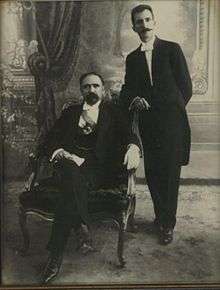
February 22, 1913: Mexico's former President Madero and Vice-President Pino Suarez shot to death

February 20, 1913: O'Malley drives the first stake for the new city of Canberra
The following events occurred in February 1913:
February 1, 1913 (Saturday)
- The U.S. Senate voted, 47-23, in favor of amending Article II, Section 1, of the United States Constitution to limit American presidents to a single, six-year term. The measure for an 18th Amendment to the Constitution was passed "by the necessary two-thirds vote and one to spare", and sent to the House for consideration.[1]
- Turkey accepted the terms of peace proposed by the Great Powers.[2]
- President Taft signed the bill authorizing the construction of a memorial to Abraham Lincoln in Washington's Potomac Park.[3]
- Died: Juan Manuel Ceballos, President of the banking house of J. M. Ceballos & Co., which had failed in 1906.
February 2, 1913 (Sunday)
- The first train departed from New York City's Grand Central Terminal, having been rebuilt, opened a moment after midnight as the world's largest train station. At 12:01 a.m., the Boston Express No. 2 became the first train to depart, with a Mr. F. M. Lamh of Yonkers credited as the first person to buy a ticket in the new terminal. On its first day, between 12:01 am and 7:00 pm, the new station attracted 150,000 visitors.[4] "At the height of its activity, in the years just after the Second World War", one historian notes, "Grand Central served about the same number of passengers as the world's busiest airport does today, even though Grand Central uses only 1 percent as much land as the airport does." [5]
- Rienzi Johnston resigned as U.S. Senator from Texas after only four weeks in office, after having been appointed on January 4. U.S. Senator-elect Morris Sheppard took office a month ahead of schedule to complete the six-year term of Joseph W. Bailey, who had resigned.
February 3, 1913 (Monday)
- At 11:00 am local time, five minutes after the Delaware House of Representatives had received the state Senate resolution for ratification, Delaware became the 36th state to vote in favor of the Sixteenth Amendment to the United States Constitution, allowing Congress to create a federal income tax. The vote in both state houses was unanimous.[6] With three-fourths of the 48 U.S. states having ratified the amendment, "The first change in the Federal Constitution in forty-three years was made certain." Wyoming and New Mexico voted their approval later in the day.[7]
- First Balkan War: Fighting between Ottoman Turkey and the Balkan league resumed at Edirne (Adrianople) and Çatalca after the peace talks in London broke down, and an agreed upon cease-fire expired.[8]
- The German railroad car manufacturer Gothaer Waggonfabrik began an aviation division, which would create one of the first heavy bombers used in war, the Gotha G.I, a twin-engine airplane that would drop bombs on the Great Britain during the First World War.[9]
February 4, 1913 (Tuesday)
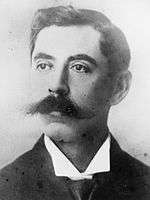
President Araujo
- The President of El Salvador, Manuel Araujo, was fatally wounded by assassins, although the initial report was that "none of the wounds is considered serious".[10] Araujo died five days later.[11] American warships were dispatched to Central America to stop the threat of a revolution.
- The wife of British Antarctic explorer Robert Falcon Scott departed from Los Angeles on the way to meet her husband in New Zealand. Mrs. Scott, unaware that he husband had died in Antarctica, told reporters, "I expect to meet Capt. Scott in Lytleton in March... I have not heard from my husband for about eighteen months, but I have no doubt whatsoever that he will arrive in New Zealand safely." [12] The next day, she set off from San Francisco on the steamer Aorangi.
- Born:
- Rosa Parks, American civil rights activist whose defiance and arrest led to the Montgomery Bus Boycott of 1955; in Tuskegee, Alabama (d. 2005)
- Richard Seaman, alias Dick Seaman, British motor racing driver who won the German Grand Prix in 1938; in Chichester (d. 1939, in an accident during the Belgian Grand Prix)
- Died: Sir John Gordon Sprigg, 83, four times Prime Minister of the Cape Colony in South Africa
February 5, 1913 (Wednesday)
- First Lieutenant Michael Moutoussis and Ensign Aristeidis Moraitinis of the Greek Navy conducted the first aerial attack on a warship in history, dropping four bombs on Turkish ships in the Dardanelles, albeit without inflicting any casualties.[13]
- Romania and Austria-Hungary signed a treaty to renew their military alliance for seven years. When World War One broke out, however, Romania would remain neutral and would later enter the war against Austria-Hungary and Germany.[14]
- The United Kingdom's House of Commons passed the Welsh Church Disestablishment bill.
- Japan's Diet voted to censure the government of Prime Minister Katsura following riots.[15]
- Spain resumed diplomatic relations with the Vatican after a nearly three-year break. Fermin Calbeton y Planchon presented his credentials to the Pope, and then spoke with the Pontiff in the latter's private residence.[16]
- Born: Takeo Nakasawa, Japanese mathematician who conceived the theory of matroid but whose work was unpublicized until more than 60 years after his death (d. 1946)
February 6, 1913 (Thursday)
- Bulgaria refused to allow foreigners to leave Adrianople in advance of the city's conquest.[2]
- Born: Mary Leakey, British anthropologist, as Mary Douglas Nicol, in London (d. 1996)
February 7, 1913 (Friday)
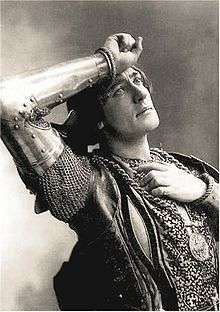
Marcoux
- Opera singer Vanni Marcoux, baritone and star of the Boston Opera Company, was hospitalized with a concussion sustained while he had been taking his bows. Marcoux had been enjoying the thunderous applause of the audience and did not realize that he was standing directly below the heavy stage curtain as it was being lowered, and was struck on the head.[17]
February 8, 1913 (Saturday)
- For the first time in more than 110 years, an incumbent United States President personally spoke before a house of the U.S. Congress. President William Howard Taft appeared before a session of the U.S. Senate to deliver a eulogy for the late Vice-President, James S. Sherman, who had died in November. "Not since 1801," the New York Times observed, "has the President spoken directly to either house of Congress." Thomas Jefferson had set the precedent of communicating to Congress by written message only, which in turn had broken the tradition set by Presidents George Washington and John Adams in speaking at the opening of Congress.[18]
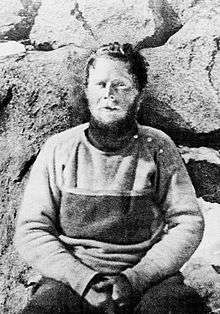
Mawson
- Explorer Douglas Mawson, the last surviving member of a three member party of explorers on the Australasian Antarctic Expedition, made it back to the expedition's base at Cape Denison. Mawson, who had suffered frostbite and illness during his trek to the base, arrived to be informed that the expedition ship Aurora had departed a few hours earlier, and that another ship would not relieve the base for another year.[19]
- The United States and Nicaragua signed the Wertzel-Chamorro Treaty, with the U.S. paying $3 million to Nicaragua for the option to build a canal across the nation to link the Atlantic and Pacific, and the right to set up bases on Corn Island and the Gulf of Fonseca. Construction of the Panama Canal was almost complete; the U.S. Senate's session ended before the treaty could be voted on.[20]
- At Mansfield, England, thirteen coal miners at the Bolsover Colliery were killed when a bucket with 800 gallons of water fell from a chain, and crashed into the workers 500 feet below.[21]
- Died: John George Brown, 81, British-born American painter known for his depictions of ordinary New York City children described as "street urchins"
February 9, 1913 (Sunday)
- At 9:05 pm Toronto time, hundreds of people observed a series of brilliant meteors streaking across the sky. The procession, first visible in the skies above Mortlach, Saskatchewan, moved south-easterly across North America. It was observed by Col. W. R. Winter from a position on Bermuda. It was reported by seven ships at sea, and then last reported off the eastern tip of Brazil near Cape Sao Roque. The procession was not observed by Professor Clarence Chant, of the Astronomy Department of the University of Toronto, but on the following day he was inundated with phone calls and letters from witnesses to the event. He systematically plotted the path of the procession, and reported his findings in a 73-page report tabled in the May–June 1913 edition of the Journal of the Royal Astronomical Society of Canada. A witness to the event was Toronto artist Gustav Hahn who made a painting following his observation. This event is also known as the "Cyrillids" because the event happened on St. Cyril's Day. In 2000, author Patrick Moore would write, "Nothing similar had ever been seen before, and nothing similar has been seen since." [22]
- Mexico's President Francisco I. Madero was trapped in a siege of the presidential palace by rebels under the command of General Felix Diaz. Former Governor of Nuevo León Bernardo Reyes, who was one of the leaders of the revolt, was killed in the exchange of gunfire.[23]
February 10, 1913 (Monday)
- The world learned the fate of Robert Falcon Scott and the other members of his Antarctic exploration team, who had perished after reaching the South Pole. The news was brought with the return of the Terra Nova.[24]
- Charles Rumney Samson, who had been the first person to fly an airplane off of the deck of a ship (on May 9, 1912) became the first person to fire a machine gun from an airplane in flight. Samson was flying over Eastchurch.[25]
- At Mucklow, West Virginia, 16 people—12 miners and 4 mine guards—were killed in fighting between striking coal miners and police.[26]
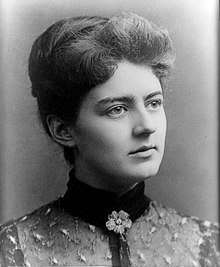
Frances Cleveland
- Former United States First Lady Frances Folsom Cleveland became the first President's widow to remarry. The widow of Grover Cleveland, who had died in 1908, was wed to Professor Thomas J. Preston, Jr. of Princeton University.[27] The only other widow of a U.S. President to remarry would be Jacqueline Kennedy, who would marry Aristotle Onassis in 1968.
- Born: Douglas Slocombe, British cinematographer, in London (d. 2016)
February 11, 1913 (Tuesday)
- Taishō political crisis in Japan: Prime Minister Katsura and his cabinet resigned, the day after tens of thousands of protesters surrounded the Parliament Building.[28]
- Mexico City became the battleground for clashes between government troops and revolutionaries.
- Five West Virginia state legislators were arrested on charges of accepting bribes in advance of a vote on the state's U.S. Senator. The six were charged with receiving a total of $20,000 to vote in favor of Senate candidate William Seymour Edwards.[29] Two days later, another six were indicted and "Every member of the West Virginia Legislature, save those against whom indictments have been returned" was issued a summons to appear before a special grand jury.[30]
- Died: Franz Schuhmeier, 49, a Socialist member of the Austrian parliament, was assassinated at a railway station in Vienna. His killer, Paul Kunschak, was the brother of one of Schuhmeier's opponents in the Chamber of Deputies, a member of the Christian Socialist Party. Schuhmeier, who had led the fight for universal suffrage in Austria, was mourned by 250,000 people.[31]
February 12, 1913 (Wednesday)
- Count Gombei Yamamoto became the new Premier of Japan. The new premier, 60 years old, was a graduate of the U.S. Naval Academy at Annapolis, one of the Class of '77.[32]
- The electoral votes were canvassed in a joint session of the U.S. Congress, and Woodrow Wilson was officially proclaimed as the winner of the election.[33]
- Turkey requested the Great Powers to intervene to end the Balkan War.
February 13, 1913 (Thursday)
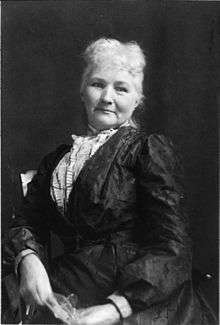
Mary Harris "Mother" Jones
- Mary Harris Jones, the 83-year-old labor activist remembered as "Mother Jones", was arrested in Charleston, West Virginia after leading a group of miners to confront Governor William Glasscock.[34] Transported to an area of Charleston that was under martial law because of confrontations between striking coal miners and company police, Jones would be tried by a military court in March, on charges of conspiracy to commit murder. Convicted on the charges, she would be sentenced to three years imprisonment, but released by the new Governor after 85 days.[35]
- The United States and France signed a five-year extension of their arbitration treaty.[2]
- Woodrow Wilson announced his resignation as Governor of New Jersey, effective March 1, three days before he was to take office as the U.S. president.[36]
- Born: Frank Tashlin, American film director and animator, in Weehawken, New Jersey (d. 1972)
February 14, 1913 (Friday)
- Outgoing U.S. President Taft vetoed the Burnett-Dillingham Immigration Bill, that would have turned away immigrant heads of families who were unable to pass a literacy test.[37] The veto would survive an attempt at an override; a historian would note later that, "Following his conscience and the advice of Charles Nagel, [Taft] defended his long-standing belief that immigration was an economic boon to the country and that Southern and Eastern Europeans could assimilate as readily as Northern and Western Europeans... Taft left the gates of America open for many immigrants as he left the White House." [38]
- Born:
- Jimmy Hoffa, American Teamsters Union leader, in Brazil, Indiana (disappeared 1975);
- Woody Hayes, American college football coach, in Clifton, Ohio (d. 1987)
- Mel Allen, American sportscaster, as Melvin Allen Israel in Birmingham, Alabama (d. 1996)
- James Pike, American Episcopal bishop and religious broadcaster, in Oklahoma City (d. 1969)
- Died: Stewart L. Woodford, 77, American diplomat and politician, minister to Spain at the time that the Spanish–American War broke out
February 15, 1913 (Saturday)
- China's Minister of Education opened the Conference on Unification of Pronunciation, the first attempt to create common standards for the Chinese language, with 44 delegates meeting in Beijing.[39]
- The Welsh Church Disestablishment bill was rejected by the British House of Lords, with only 52 in favor and 252 against.[40]
- Emilio Vasquez Gomez crossed the U.S.-Mexican border at Columbus, New Mexico into Palomas, and proclaimed himself as President of Mexico, with plans to journey to the capital to take office.[41]
- Former Venezuelan President Cipriano Castro was permitted entry into the United States by federal court order.[27]
- Born: Erich Eliskases, Austrian chess grandmaster, in Innsbruck (d. 1997)
February 16, 1913 (Sunday)
- West of Pierre, South Dakota, Hattie May Foster, a 14-year-old student, spotted the corner of a lead marker sticking out of the ground and unearthed it.[42] What Foster had located was a marker that had been set 170 years earlier by a team of French explorers under the command of Pierre Gaultier de La Vérendrye and François de La Vérendrye, who had marked the furthest point explored by them before they began their journey home. Inscribed on one side was "Anno XXVI Regni Ludovici XV Prorege; Illustrissimo Domino Domino Marchione; De Beauharnois M D CC XXXXI; Petrus Gaultier de Laverendrie Posvit", and on the other "Pose par le Chevalier de Lavr to jo Louy la Londette Amiotte, Le 30 de mars 1743" (March 30, 1743).[43]
- A nine-hour armistice in the Mexican Revolution went into effect in Mexico City.
- Joseph Hertz of New York City was elected as Chief Rabbi of the United Hebrew Congregations of the British Empire.
February 17, 1913 (Monday)
- The "Armory Show", officially the first International Exhibition of Modern Art, opened in New York City at the Sixty-ninth Regiment Armory, at the corner of Lexington Avenue and 26th Street. The exhibition, which would last until March 15, featured 1,250 paintings, sculptures and decorative works from over 300 European and American masters,[44] including Marcel Duchamp's Nude Descending a Staircase, No. 2. Other artists who were represented were Pablo Picasso, Paul Cézanne, Wassily Kandinsky, Henri Matisse, Claude Monet and Vincent van Gogh. American artists were James McNeill Whistler, Edward Hopper, Childe Hassam, Mary Cassatt, and George Bellows.[45] The Armory Show was the first major exhibition in the United States of modern art and would be called by art historian Hélène Seckel as "the relaunching, if not actually the birth, of the art market", with wealthy collectors being inspired to acquire the work of modern artists.[46] [47]
- U.S. President Taft assured Mexican President Madero that the U.S. had no plans to intervene in the Mexican Revolution other than to protect U.S. citizens.[48]
- Died: Edward Stanley Gibbons, 72, English philatelist and creator of stamp catalogs
February 18, 1913 (Tuesday)
- After fighting against the rebels, federal troops in Mexico arrested President Francisco I. Madero and Vice-President José Pino Suárez. General Aureliano Blanquet ordered his soldiers to enter the palace and arrest the President and his cabinet. The President and Vice-President both resigned at 10:24 pm, and Foreign Minister Pedro Lascuráin, second in line for succession, became the interim President. When the Mexican Congress confirmed General Victoriano Huerta as the new leader, President Lascuráin resigned at 11:20 pm, having served for 56 minutes.[49]
- Raymond Poincaré was inaugurated as President of France.
- Born: Artur Axmann, German leader of the Hitler Youth from 1940 to 1945, in Hagen (d. 1996)
- Died:
- George Washington Custis Lee, 80, President Emeritus of Washington and Lee University and former Confederate General, son of Robert E. Lee
- George Lewis Becke, Australian author
February 19, 1913 (Wednesday)
- Gustavo A. Madero, brother of the deposed President, was executed on orders of General Félix Díaz. Gustavo was "subjected to the 'fugitive law'", where prisoners were released and given a chance to flee while guns were fired at them.[50]
- An attempt to override President Taft's veto of the Immigration Bill failed in the House by five votes, after having passed the Senate, 72–18, the day before. Although the vote was 213–114 in favor of overcoming the President's veto, two-thirds (218) of the 327 representatives present were required to agree.[51]
February 20, 1913 (Thursday)
- The first survey stake for what would become the city of Canberra, capital of Australia, was driven into the ground by King O'Malley, the Minister for Home Affairs.[52]
- The most destructive fire in Tokyo, in almost 60 years, broke out at a Salvation Army hall in the Kanda district, spread over one-half of a square mile, and destroyed 1,500 homes and buildings.[53]
- Julian Krein, futurist music composer, in Moscow (d. 1996)
- Born: Tommy Henrich, American baseball player, in Massillon, Ohio (d. 2009)
February 21, 1913 (Friday)
- Sir Harcourt Butler, the Secretary of State for Education in British India, specified the goals for creating 14 universities across India.[54]
- The State of Arkansas outlawed the practice of convict leasing, after the state legislature had passed a bill proposed by Governor George Washington Donaghey and signed by Donaghey's successor, Joseph T. Robinson.[55]
- U.S. District Judge Nathan Goff, Jr. was elected as U.S. Senator for West Virginia by the state legislature, with 49 votes, compared to 14 votes for the three other candidates.[56]
February 22, 1913 (Saturday)
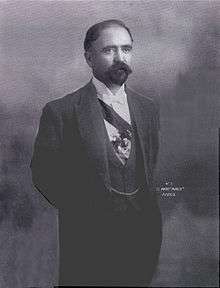
Madero

Huerta
- Four days after their forced resignations, former Mexican President Madero, and Vice-President Pino Suarez, were shot to death after being transported from the presidential palace to a prison.[57] The official explanation by President Huerta was that the two men were being transported in automobiles and "two-thirds of the way to the penetentiary, they were attacked by an armed group...and the prisoners tried to escape. An exchange of shots then took place in which one of the attacking party was killed, two were wounded and both prisoners killed." [58] Other accounts were that Major Francisco Cardenas, who was escorting the prisoners, shot both men[59] and that President Huerta was told by U.S. Ambassador Henry Lane Wilson to do "whatever he thought best for the country", after which "Huerta did just that", having the two men executed at the prison.[60] The subsequent government investigation "resulted in a decision that no one could be held legally responsible".[61]
- President Taft dispatched 4,000 men to Galveston, Texas, for a possible deployment to Mexico.[62] The force was increased two days later to 10,000 people.[63]
- The U.S. Naval Academy, which would later be ranked by the Helms Foundation as the best team of the 1912-13 men's basketball season, closed its schedule with a 67-18 win over Georgetown University and a 9-0 finish. The Midshipmen outscored their opponents 501-187 in nine games, defeating them by an average of 35 points per game.
- Born: Ranko Marinković, Croatian author, in Komiža, Austria-Hungary (d. 2001)
- Died:
- Empress Dowager Longyu, 45, widow of the Guangxu Emperor and former co-regent for China's last emperor Puyi
- Ferdinand de Saussure, 55, Swiss philologist who pioneered structural linguistics
February 23, 1913 (Sunday)
- Joseph Stalin was arrested by the Russian secret police agency, the Okhrana, upon his arrival at the Kalashnikov Exchange at Petrograd (now Saint Petersburg), where International Women's Day was being celebrated. The future dictator of the Soviet Union, Stalin would be imprisoned for the next four years by the Tsarist government, until his release in 1917 a few months before the Russian Revolution.[64]
- The United Synagogue of America held its initial meeting, at which time it changed to its present name from the working title of "Agudath Jeshurun- A Union for Promoting Traditional Judaism in America".[65]
- Romania agreed to a mediation of its boundary dispute with Bulgaria.[27]
- Born: Sabine Sicaud, French girl poet who was published at 13, but died of osteomyelitis at age 15; in Villeneuve-sur-Lot (d. 1928)
February 24, 1913 (Monday)
- The first radio transmission from Antarctica was made, with Australasian Expedition leader Douglas Mawson telegraphing a message by wireless to Australia.[66]
- Born:
- Richard M. Goodwin, American mathematician and economist, in Newcastle, Indiana (d. 1996)
- Walter Goldschmidt, American anthropologist, in San Antonio, Texas (d. 2010)
February 25, 1913 (Tuesday)
- U.S. Secretary of State Philander Knox proclaimed that the Sixteenth Amendment had been ratified by the necessary three-fourths of the states, officially making a federal income tax part of the Constitution.[67] An 1894 attempt by the U.S. government to tax incomes had been found unconstitutional, except as regards salaries and wages. The first federal income tax laws passed, after the Amendment took effect, provided for a rate of one percent for incomes of $20,000 or less[68]
- Enrique Varela resigned as Prime Minister of Peru.
- Born:
- Jim Backus, American comic actor known for his roles as "Mr. Magoo" and "Thurston Howell III"; in Cleveland (d. 1989)
- Gert Fröbe, German film actor who was the title character in (Goldfinger), in Oberplanitz (now part of Zwickau) (d. 1988
- Died: Jake DeRosier, 33, American motorcycle racer, of complications from surgeries for an accident a year earlier.
February 26, 1913 (Wednesday)
- Federico Luna Peralta became the new Prime Minister of Peru.[27]
- Born: George Barker, British poet, in Loughton (d. 1991)
- Died:
- Felix Draeseke, 77, German opera and symphony composer
- Bud Fowler, 54, the first known African-American professional baseball player
February 27, 1913 (Thursday)
- The concept of the "isotope", referring to a variation of a chemical element containing the same number of protons but a different number of neutrons, was introduced by British radiochemist Frederick Soddy, in a February 27 address before Britain's Royal Society, when he referred to "atoms of the same chemical properties, non-separable by any known process"; the term itself, suggested to Soddy by his friend, Edinburgh physician Margaret Todd, would not be introduced until December 4, when he used it in the British scientific journal Nature. [69]
- Born:
- Irwin Shaw (pen name for Irwin Gilbert Shamforoff), American novelist (d. 1984);
- T. B. Ilangaratne, Sri Lankan author, dramatist, actor and politician, in Hataraliyadda (d. 1992)
- Paul Ricoeur, French philosopher, in Valence (d. 2005)
- Died:
- Sir William Henry White, 68, chief constructor of the British Navy
- Leonard Kamungu, 35, Malawian Christian missionary, of poisoning.
February 28, 1913 (Friday)
- Proof of the existence of the pygmy hippopotamus (Choeropsis liberiensis) was demonstrated by German animal merchant Carl Hagenbeck in Liberia. After "having made sure that the species was much less rare than he had thought",[70] Hagenbeck shot and killed one. The next day, he would capture a live pygmy hippo.
- The largest pinniped ever recorded was a southern elephant seal (Mirounga leonina), killed at Possession Bay of South Georgia Island, more than 22 feet in length and weighing almost 9,000 pounds.[71]
- At least 20 people were killed in a fire at the Dewey Hotel in Omaha, Nebraska.[72]
- The Webb-Kenyon bill, prohibiting the interstate shipment of alcohol into dry territory for purposes of resale, passed by the House and the Senate, was vetoed by President Taft.[2] The veto would be overridden the same day by the Senate, and the next day by the House.[2]
- The New York City garment workers' strike was ended.[2]
References
- ↑ "Senate Votes, 47-23, for Six-year Term", New York Times, February 2, 1913
- 1 2 3 4 5 6 The American Year Book, Volume 4 (T. Nelson & Sons, 1914)
- ↑ "Lincoln Memorial Assured— Taft Signs Bill Providing for a Greek Temple in Washington", New York Times, February 2, 1913
- ↑ "City Folks Crowd New Grand Central", New York Times, February 3, 1913
- ↑ Francis Morrone and James Iska, The Architectural Guidebook to New York City (Gibbs Smith, 2002) p152
- ↑ "Delaware's Vote Decides", New York Times, February 4, 1913
- ↑ "Income Tax Ratified by Delaware's Vote", New York Times, February 4, 1913
- ↑ Spencer C. Tucker, ed., World War I: A Student Encyclopedia (ABC-CLIO, 2005) p286
- ↑ Antony L. Kay and J. R. Smith, German Aircraft of the Second World War: Including Helicopters and Missiles (Naval Institute Press, 2002) pp19-20
- ↑ "Wound Salvador President", New York Times, February 6, 1913
- ↑ "Wounded President Dies", New York Times, February 10, 1913
- ↑ "Starts to Meet Explorer", New York Times, February 5, 1913
- ↑ Walter J. Boyne, ed., Air Warfare: an International Encyclopedia: A-L (ABC-CLIO, 2002) pp. 66, 268.
- ↑ Keith Hitchins, Rumania 1866-1947 (Oxford University Press, 1994) p152
- ↑ "Katsura Censured by Diet", New York Times, February 6, 1913
- ↑ "Spain's Envoy at Vatican, New York Times, February 6, 1913
- ↑ "Curtain Knocks Out Singer", Washington Post, February 8, 1913, p1
- ↑ "Mr. Taft Addresses Senate — Ends Century-Old Tradition in To-Morrow's Memorial Exercises", New York Times, February 7, 1913
- ↑ Tom Griffiths, Slicing the Silence: Voyaging to Antarctica (Harvard University Press, 2007) p27; 2007 Year Book Australia (Australia Bureau of Statistics, 2007) p17
- ↑ Lawrence Lenz, Power and Policy: America's First Steps to Superpower, 1889-1922 (Algora Publishing, 2008) p176
- ↑ "Falling Bucket Kills 13 Miners", New York Times, February 9, 1913
- ↑ Patrick Moore, The Data Book of Astronomy (CRC Press, 2000) p249
- ↑ "ARMY REVOLTS, SEIZES MEXICO CITY; MADERO'S TROOPS HOLD THE PALACE; 300 ARE SLAIN IN THE FIRST CLASH", New York Times, February 10, 1913, p1; John Mason Hart, Revolutionary Mexico: The Coming and Process of the Mexican Revolution (University of California Press, 1989) p260
- ↑ Roland Huntford, Race for the South Pole: The Expedition Diaries of Scott and Amundsen (Continuum International, 2010) p304
- ↑ Julian Thompson, Imperial War Museum Book of the War at Sea 1914-18 (Pan Macmillan, 2011)
- ↑ "Sixteen Are Killed in Mine Rioting", New York Times, February 11, 1913
- 1 2 3 4 "Record of Current Events", The American Monthly Review of Reviews (April 1913), pp. 414–417
- ↑ "Katsura Cabinet Is Out", New York Times, February 12, 1913; Kevin M. Doak, A History of Nationalism in Modern Japan: Placing the People (BRILL, 2007) pp104-105
- ↑ "Arrests for Bribery in Senate Contest", New York Times, February 12, 1913
- ↑ "Six Legislators Indicted", New York Times, February 15, 1913
- ↑ William M. Johnston, The Austrian Mind: An Intellectual and Social History, 1848-1938 (University of California Press, 1983) pp100-101
- ↑ "Annapolis Graduate Premier of Japan", New York Times, February 13, 1913
- ↑ "Wilson Is Elected in Quaint Ceremony", New York Times, February 13, 1913
- ↑ "Riot in the Capitol", Washington Post, February 14, 1913, p1
- ↑ Edward M. Steel, The Court-Martial of Mother Jones (University Press of Kentucky, 1995) p3
- ↑ "Wilson to Resign March 1", New York Times, February 14, 1913
- ↑ "Immigration Bill Veto at the Last Minute", New York Times, February 15, 1913
- ↑ Hans P. Vought, The Bully Pulpit And The Melting Pot: American Presidents And The Immigrant, 1897-1933 (Mercer University Press, 2004) p93
- ↑ Jing Tsu, Sound and Script in Chinese Diaspora (Harvard University Press, 2010)
- ↑ "Angered by the Bishops", New York Times, February 16, 1913
- ↑ "Gomez Proclaims that he is President", New York Times, February 16, 1913
- ↑ Bernard DeVoto, The Course of Empire (Houghton Mifflin Harcourt, 1998) p269
- ↑ Mark H. Brown, The Plainsmen of the Yellowstone: A History of the Yellowstone Basin (University of Nebraska Press, 1977) p22
- ↑ Gerry Souter, Edward Hopper: Light and Dark (Parkstone International) p43
- ↑ John Baxter, Von Sternberg (University Press of Kentucky, 2010) p17
- ↑ Dan Franck, Bohemian Paris: Picasso, Modigliani, Matisse, and the Birth of Modern Art (Grove Press, 2003)
- ↑ "The 1913 Armory Show: America’s First Art War", by Tom McCormack, Art21 magazine, March/April 2017
- ↑ "Madero Gratified by Reply", New York Times, February 18, 1913
- ↑ Wilfrid Hardy Callcott, Liberalism in Mexico, 1857-1929 (Stanford University Press, 1931) p228.
- ↑ "Swift End of Gustavo Madero", New York Times, February 20, 1913
- ↑ "House Upholds Taft on Literacy Test", New York Times, February 20, 1913
- ↑ King O'Malley: Canberra Museum and Gallery, 29 October 2011 - 12 March 2012 (Canberra Museum & Gallery, 2011) p42
- ↑ Joshua Hammer, Yokohama Burning: The Deadly 1923 Earthquake And Fire That Helped Forge the Path to World War II (Simon and Schuster, 2006) p82
- ↑ P. N. Chopra, A Comprehensive History of India, Volume 3 (Sterling Publishers, 2003) p228
- ↑ Jeannie M. Whayne, Arkansas: A Narrative History (University of Arkansas Press, 2002) p279
- ↑ "West Virginia Names Goff", New York Times, February 22, 1913
- ↑ "MADERO AND SUAREZ SHOT TO DEATH AS GUARDS FIRE ON RESCUE PARTY", Washington Post, February 24, 1913, p1
- ↑ Edward I. Bell, The Political Shame of Mexico, Volume 3 (McBride, Nast & Co., 1914) p318
- ↑ Godfrey Hodgson, Woodrow Wilson's Right Hand: The Life of Colonel Edward M. House (Yale University Press, 2006) p86
- ↑ Héctor Aguilar Camín and Lorenzo Meyer, In the Shadow of the Mexican Revolution: Contemporary Mexican History, 1910-1989 (University of Texas Press, 1993) p35
- ↑ Thomas H. Russell, Mexico In Peace and War (Reilly & Britton Syndicate, 1914) p86
- ↑ "Taft Sends Army Close to Mexico", New York Times, February 23, 1913
- ↑ "More Troops to Galveston", New York Times, February 25, 1913
- ↑ Robert Service, Stalin: A Biography (Harvard University Press, 2005) pp90-91
- ↑ Michael R. Cohen, The Birth of Conservative Judaism: Solomon Schechter's Disciples and the Creation of an American Religious Movement (Columbia University Press, 2012)
- ↑ "Radio telegram from Douglas Mawson to Professor Edgeworth David", National Archives of Australia
- ↑ "Amendments to the Constitution of the United States of America", FindLaw.com
- ↑ Patrick Robertson, Robertson's Book of Firsts: Who Did What for the First Time (Bloomsbury Publishing USA, 2011)
- ↑ Per F. Dahl, Flash of the Cathode Rays: A History of J J Thomson's Electron (CRC Press, 1997) p290, n87, n90; p425
- ↑ Bernard Heuvelmans, On The Track Of Unknown Animals (Taylor & Francis, 1995) pp48-50 cited by Alan H. Simmons, Faunal Extinction in an Island Society: Pygmy Hippopotamus Hunters of Cyprus (Springer, 1999) p306
- ↑ Mark Carwardine, Natural History Museum Animal Records (Sterling Publishing Company, 2008) p61
- ↑ "Score Die in Fire in Omaha", New York Times, March 1, 1913
This article is issued from
Wikipedia.
The text is licensed under Creative Commons - Attribution - Sharealike.
Additional terms may apply for the media files.